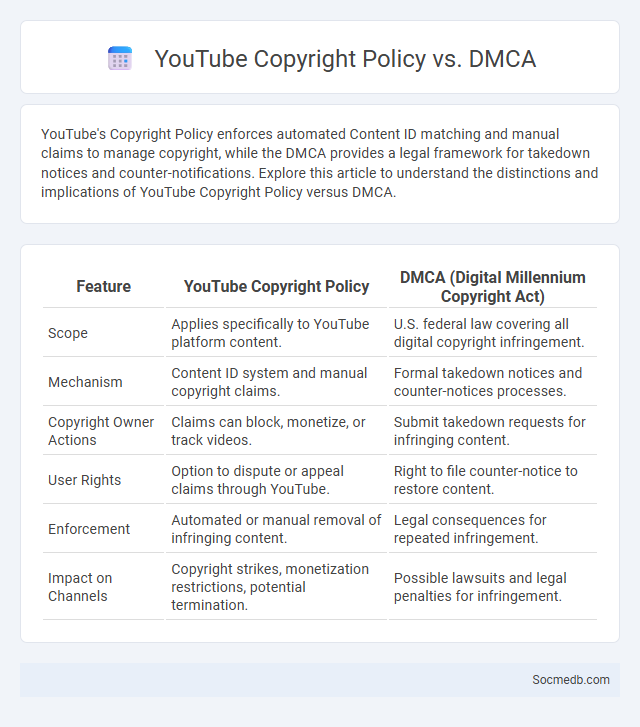
Photo illustration: YouTube Copyright Policy vs DMCA
YouTube's Copyright Policy enforces automated Content ID matching and manual claims to manage copyright, while the DMCA provides a legal framework for takedown notices and counter-notifications. Explore this article to understand the distinctions and implications of YouTube Copyright Policy versus DMCA.
Table of Comparison
| Feature | YouTube Copyright Policy | DMCA (Digital Millennium Copyright Act) |
|---|---|---|
| Scope | Applies specifically to YouTube platform content. | U.S. federal law covering all digital copyright infringement. |
| Mechanism | Content ID system and manual copyright claims. | Formal takedown notices and counter-notices processes. |
| Copyright Owner Actions | Claims can block, monetize, or track videos. | Submit takedown requests for infringing content. |
| User Rights | Option to dispute or appeal claims through YouTube. | Right to file counter-notice to restore content. |
| Enforcement | Automated or manual removal of infringing content. | Legal consequences for repeated infringement. |
| Impact on Channels | Copyright strikes, monetization restrictions, potential termination. | Possible lawsuits and legal penalties for infringement. |
Understanding YouTube Copyright Policy
YouTube's Copyright Policy enforces strict guidelines to prevent unauthorized use of copyrighted content, including videos, music, and images, ensuring creators' intellectual property rights are protected. The platform employs Content ID technology to automatically detect and manage copyrighted materials, allowing rights holders to monetize, track, or block infringing content. Users must understand the implications of copyright strikes, which can lead to account penalties or termination, emphasizing the importance of uploading original or properly licensed media.
What is the DMCA?
The DMCA, or Digital Millennium Copyright Act, is a United States law that protects copyrighted content on social media platforms by providing a legal framework for the removal of infringing material. It allows content creators and copyright holders to submit takedown notices to platforms like YouTube, Facebook, and Instagram, ensuring unauthorized use of their work is swiftly addressed. Understanding the DMCA helps you protect your original content and navigate copyright issues effectively on social media.
Copyright Claims on YouTube: An Overview
Copyright claims on YouTube protect original content creators by identifying unauthorized use of their work and enable them to monetize, block, or track the usage. Your videos may be flagged if they contain copyrighted music, clips, or images without permission, leading to demonetization or removal. Understanding YouTube's Content ID system and dispute process helps you manage claims efficiently and maintain your channel's compliance.
Key Differences: YouTube Copyright Policy vs DMCA
YouTube Copyright Policy specifically targets unauthorized use of copyrighted content on its platform, enforcing strict measures like Content ID and manual takedown requests to protect creators' rights. The DMCA (Digital Millennium Copyright Act) is a broader U.S. law that provides a legal framework for copyright holders to request removal of infringing content from various online platforms. When managing Your online presence, understanding that YouTube's policy operates within DMCA's legal boundaries ensures effective protection and compliance against copyright infringement.
The Copyright Claim Process on YouTube
YouTube's copyright claim process involves content identification through automated systems like Content ID, which scans uploads against a database of copyrighted material. When a match is detected, rights holders can choose to block, monetize, or track the video's viewership, enforcing their intellectual property rights without manual review. Creators disputing claims must submit counter-notifications following YouTube's strict policies to avoid potential penalties including video removal or channel strikes.
DMCA Takedown Notices Explained
DMCA takedown notices are formal requests submitted under the Digital Millennium Copyright Act to remove infringing content from social media platforms such as Facebook, Instagram, and Twitter. These notices require the complainant to provide specific information, including a description of the copyrighted work and the allegedly infringing material, ensuring swift removal of unauthorized posts or videos. Social media companies must comply promptly to avoid liability, while users have the right to submit counter-notices if they believe their content was wrongfully removed.
YouTube’s Content ID System
YouTube's Content ID system automatically scans uploaded videos to identify copyrighted material by matching it against a vast database of rights holders' files. Your content is protected or monetized based on the system's detection, helping creators and copyright owners enforce their intellectual property rights. This technology enhances the platform's ability to manage copyright claims efficiently while allowing YouTube to maintain a balanced ecosystem for users and rights holders.
Appeal and Dispute Mechanisms
Social media platforms implement robust appeal and dispute mechanisms to protect users' rights and ensure fair content moderation. Your ability to challenge content removal or account suspension involves submitting appeals that are reviewed by specialized teams to maintain transparency and accountability. Effective appeal processes enhance trust and promote a balanced digital environment by addressing grievances promptly and fairly.
Creator Responsibilities and Rights
Creators on social media platforms are responsible for producing original, respectful content that adheres to community guidelines while protecting their intellectual property rights through proper attribution and copyright registration. Platforms increasingly support creators by implementing tools for content monetization, rights management, and transparent reporting of content usage. Understanding and exercising their rights, including fair use and content ownership, empowers creators to maintain control over their work and navigate digital ecosystems effectively.
Best Practices to Avoid Copyright Issues
To avoid copyright issues on social media, always use original content or properly licensed materials, such as royalty-free images, videos, and music. You should credit creators when sharing their work and seek explicit permission for content that is not yours. Understanding the platform's copyright policies and utilizing tools like content ID systems helps protect Your account from takedown notices and legal complications.
 socmedb.com
socmedb.com